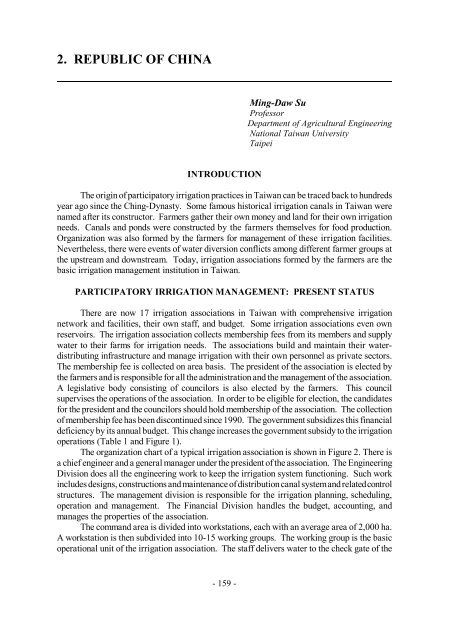Organizational Change for Participatory Irrigation Management
Organizational Change for Participatory Irrigation Management
Organizational Change for Participatory Irrigation Management
Create successful ePaper yourself
Turn your PDF publications into a flip-book with our unique Google optimized e-Paper software.
2. REPUBLIC OF CHINA<br />
INTRODUCTION<br />
- 159 -<br />
Ming-Daw Su<br />
Professor<br />
Department of Agricultural Engineering<br />
National Taiwan University<br />
Taipei<br />
The origin of participatory irrigation practices in Taiwan can be traced back to hundreds<br />
year ago since the Ching-Dynasty. Some famous historical irrigation canals in Taiwan were<br />
named after its constructor. Farmers gather their own money and land <strong>for</strong> their own irrigation<br />
needs. Canals and ponds were constructed by the farmers themselves <strong>for</strong> food production.<br />
Organization was also <strong>for</strong>med by the farmers <strong>for</strong> management of these irrigation facilities.<br />
Nevertheless, there were events of water diversion conflicts among different farmer groups at<br />
the upstream and downstream. Today, irrigation associations <strong>for</strong>med by the farmers are the<br />
basic irrigation management institution in Taiwan.<br />
PARTICIPATORY IRRIGATION MANAGEMENT: PRESENT STATUS<br />
There are now 17 irrigation associations in Taiwan with comprehensive irrigation<br />
network and facilities, their own staff, and budget. Some irrigation associations even own<br />
reservoirs. The irrigation association collects membership fees from its members and supply<br />
water to their farms <strong>for</strong> irrigation needs. The associations build and maintain their waterdistributing<br />
infrastructure and manage irrigation with their own personnel as private sectors.<br />
The membership fee is collected on area basis. The president of the association is elected by<br />
the farmers and is responsible <strong>for</strong> all the administration and the management of the association.<br />
A legislative body consisting of councilors is also elected by the farmers. This council<br />
supervises the operations of the association. In order to be eligible <strong>for</strong> election, the candidates<br />
<strong>for</strong> the president and the councilors should hold membership of the association. The collection<br />
of membership fee has been discontinued since 1990. The government subsidizes this financial<br />
deficiency by its annual budget. This change increases the government subsidy to the irrigation<br />
operations (Table 1 and Figure 1).<br />
The organization chart of a typical irrigation association is shown in Figure 2. There is<br />
a chief engineer and a general manager under the president of the association. The Engineering<br />
Division does all the engineering work to keep the irrigation system functioning. Such work<br />
includes designs, constructions and maintenance of distribution canal system and related control<br />
structures. The management division is responsible <strong>for</strong> the irrigation planning, scheduling,<br />
operation and management. The Financial Division handles the budget, accounting, and<br />
manages the properties of the association.<br />
The command area is divided into workstations, each with an average area of 2,000 ha.<br />
A workstation is then subdivided into 10-15 working groups. The working group is the basic<br />
operational unit of the irrigation association. The staff delivers water to the check gate of the
















